Embedding Acoustic Analysis in Landscape Architecture Design Processes: A Case Study of Munich Airport
Abstract
1. Introduction
1.1. Background: Airport Noise, Mitigation, and Performative Acoustic Grounds
1.2. Motivation: Expanding Methodologies in Landscape Architecture
1.3. Challenges: Methods for Addressing Acoustics beyond Walls
1.4. Objective: A Method for Embedding Acoustic Performance in the Design of Ground Forms
1.5. Paper Structure
1.6. State-of-the-Art
1.6.1. Urban Noise
1.6.2. Noise Mitigation through Ground-Forming
1.6.3. Noise Simulation Methods and Tools
1.6.4. Knowledge Gaps
- A lack of research-by-design methods for performative landscapes, namely for noise mitigation in open urban spaces.
- A lack of methods supporting the design of data-driven ground-forming using noise data.
- A lack of workflows that support the integration of acoustic simulation in the design process as an alternative to employing separate tools for design and simulations.
2. Materials and Methods
2.1. Context
2.2. Case-Study Site
2.3. A Method for Incorporating Acoustic Performance in Design
- What data is needed for acoustic ground-forming, and how the respective data can be obtained.
- How to translate noise data into the desired landscape design principles, which can guide the parametric design.
- How to develop and evaluate the design of landscape formations in terms of their acoustic performance.
2.4. Noise Analysis
2.4.1. On-Line Data Gathering
2.4.2. On-Site Noise Measurement
- Devices and application
- Sampling method
2.5. Design
2.5.1. Desired Noise Reduction Plan
2.5.2. A Master-Plan
2.5.3. Design Strategies
- Design 1: Marshlands
- Design 2: Undulating Grounds
- Design 3: Large Mounds
2.6. Acoustic Simulation
2.6.1. Setup
2.6.2. Base Model: A Digital Twin
2.6.3. Sound Calculation
2.6.4. Simulation Testing Areas
2.6.5. Acoustic Evaluation of the Design
3. Results
3.1. Noise
3.2. Comparison of On-Line and On-Site Noise Measurements
3.3. Design Simulations
3.3.1. Design 1: Marshlands
3.3.2. Design 2: Undulating Forms
3.3.3. Design 3: Large Mounds
3.3.4. Comparison of Acoustic Performance
4. Discussion
4.1. Summary of Methodology and Contribution
4.2. Limitations
4.3. Future Work
- Noise analysis—Future work will aim to increase the accuracy of on-site noise sampling, such as by using an external microphone and performing calibration between it and the sampling devices. Future noise data gathering will also address the effect of weather on aircraft noise propagation [45]. In addition, it will further develop the forms of representation of the noise, which will integrate its behavior through time, and thus provide more accurate capturing of it compared to existing 2D contour maps. In addition, it will aim to integrate with GIS-based, open-source tools, which integrate noise from several sources in an urban context [46].
- Design strategies—future research will deepen the link between form and performance in the acoustic design of grounds and rely on more frequent iterations to evaluate the design strategy. In addition, it will test the role of shape regularity vs. shape irregularity in landscape-forming and its effectiveness as a design strategy for noise mitigation. It will also aim to integrate material properties in the design and simulation and assess their respective contribution to acoustic performance. Incorporating the material properties in the simulations will allow the evaluation of more accurate strategies, such as the marshlands, which rely on the alternation between low soil mounds and water surfaces rather than on the construction of high soil mounds.
- Acoustic simulation—future work will promote the integration of acoustic simulation tools in a design environment. In addition, the presented setup will be used in tandem with other experimental algorithms to optimize acoustic performance using tools such as the Grasshopper Galapagos genetic algorithm plug-in. In parallel, the research will develop methods for supporting simulations on a larger landscape scale. Such simulations could allow testing performance locally, globally, and in the surrounding areas. Future research will also aim to use statistical analysis tools, such as chi-square, to compare the performance of different designs. In addition, in future simulations, weather can be incorporated as a ‘worst-case’ simulation scenario in which the wind blowing from source to receiver (downwind) is likely to result in higher noise levels at the receiver point compared to conditions without wind.
5. Conclusions
Author Contributions
Funding
Data Availability Statement
Acknowledgments
Conflicts of Interest
References
- World Health Organization. Burden of Disease from Environmental Noise: Quantification of Healthy Life Years Lost in Europe; World Health Organization Regional Office for Europe: Copenhagen, Denmark, 2011. [Google Scholar]
- World Health Organization. Environmental Noise Guidelines for the European Region; World Health Organization Regional Office for Europe: Copenhagen, Denmark, 2018. [Google Scholar]
- Nugent, C.; Blanes, N.; Fons, J.; Sainz, M.; Ramos, M.; Domingues, F.; van Beek, A.; Houthuijs, D. Noise in Europe 2014; Publications Office of the European Union: Luxembourg, 2014. [Google Scholar]
- Peris, E. Environmental Noise in Europe—2020; Publications Office of the European Union: Luxembourg, 2020. [Google Scholar]
- Boucsein, B.; Christiaanse, K.; Kasioumi, E.; Salewski, C. The Noise Landscape: A Spatial Exploration of Airports and Cities; nai010 Publishers: Rotterdam, The Netherlands, 2017. [Google Scholar]
- Kasioumi, E. Emerging Planning Approaches in Airport Areas: The Case of Paris-Charles de Gaulle (CDG). Reg. Stud. Reg. Sci. 2015, 2, 408–414. [Google Scholar] [CrossRef]
- Ang, L.Y.L.; Cui, F. Remote Work: Aircraft Noise Implications, Prediction, and Management in the Built Environment. Appl. Acoust. 2022, 198, 108978. [Google Scholar] [CrossRef] [PubMed]
- Niesten, J.; Tenpierik, M.J.; Krimm, J. Sound Predictions in an Urban Context. Build. Acoust. 2022, 29, 27–52. [Google Scholar] [CrossRef]
- Morillas, J.M.B.; Gozalo, G.R.; González, D.M.; Moraga, P.A.; Vílchez-Gómez, R. Noise Pollution and Urban Planning. Curr. Pollut. Rep. 2018, 4, 208–219. [Google Scholar] [CrossRef]
- Cantrell, B.E.; Mekies, A. Codify: Parametric and Computational Design in Landscape Architecture; Routledge: New York, NY, USA; Taylor & Francis Group: London, UK, 2018. [Google Scholar]
- Bar-Sinai, K.L.; Alon-Mozes, T.; Sprecher, A. Editing Landscapes: Experimental Frameworks for Territorial-Based Robotic Fabrication. Front. Archit. Res. 2022. [CrossRef]
- Lenzholzer, S.; Duchhart, I.; Koh, J. ‘Research through Designing’ in Landscape Architecture. Landsc. Urban Plan 2013, 113, 120–127. [Google Scholar] [CrossRef]
- Moosavi, S. Design Experimentation for Nature-based Solutions: Towards a Definition and Taxonomy. Environ. Sci. Policy 2022, 138, 149–161. [Google Scholar] [CrossRef]
- Vomhof, M.; Vasey, L.; Brauer, S.; Eggenschwiler, K.; Strauss, J.; Gramazio, F.; Kohler, M. Robotic Fabrication of Acoustic Brick Walls. In Proceedings of the 34th Annual Conference of the Association for Computer-Aided Design in Architecture (ACADIA 2014), Los Angeles, CA, USA, 23–25 October 2014; pp. 555–564. [Google Scholar]
- Hauberg, J.; Tamke, M.; Thomsen, M.R. Research by Design-a Research and Teaching Concept. In Proceedings of the Conference Theory by Design: Architectural Research Made Explicit in the Design Teaching Studio, Antwerpen, Belgium, 29–31 October 2012; pp. 335–342. [Google Scholar]
- United Nations. Glossary of Environment Statistics, Studies in Methods; Series F; United Nations: New York, NY, USA, 1997. [Google Scholar]
- Bartolomaeus, W. Richtlinien Für Den Lärmschutz an Straßen-RLS19. Lärmbekämpfung 2019, 14. [Google Scholar] [CrossRef]
- Isermann, U.; Vogelsang, B. AzB and ECAC Doc.29—Two Best-Practice European Aircraft Noise Prediction Models. Noise Control. Eng. J. 2010, 58, 455. [Google Scholar] [CrossRef]
- European Commission. Directive 2002/49/EC of the European Parliament and the Council of 25 June 2002 Relating to the Assessment and Management of Environmental Noise. Off. J. Eur. Communities 2002, 189, 2002. [Google Scholar]
- Federal Aviation Administration. The FAR Part 150 Airport Noise Compatibility Planning Programm. Available online: www.faa.gov/about/office_org/headquarters_offices/apl/noise_emissions/planning_toolkit/media/II.B.pdf (accessed on 15 November 2022).
- EN ISO 717-1:2020; Acoustics—Rating of Sound Insulation in Buildings and of Building Elements—Part 1: Airborne Sound Insulation (ISO 717-1:2020). ISO: Geneva, Switzerland, 2021. Available online: https://www.beuth.de/de/norm/din-en-iso-717-1/329418506 (accessed on 20 December 2022).
- EN ISO 16283-3:2016; Acoustics—Field Measurement of Sound Insulation in Buildings and of Building Elements—Part 3: Façade Sound Insulation (ISO 16283-3:2016). ISO: Geneva, Switzerland, 2016. Available online: https://www.beuth.de/de/norm/din-en-iso-16283-3/240093697 (accessed on 20 December 2022).
- Maekawa, Z.; Rindel, J.; Lord, P. Environmental and Architectural Acoustics; CRC Press: Boca Raton, FL, USA, 2010. [Google Scholar]
- Netjasov, F. Contemporary Measures for Noise Reduction in Airport Surroundings. Appl. Acoust. 2012, 73, 1076–1085. [Google Scholar] [CrossRef]
- Sorvig, K.; Thompson, J.W. Quietly Defend Silence. In Sustainable Landscape Construction: A Guide to Green Building Outdoors; Sorvig, K., Thompson, J.W., Eds.; Island Press/Center for Resource Economics: Washington, DC, USA, 2018; pp. 363–372. [Google Scholar]
- Schiphol Airport Website. Landscape Design Plan to Combat Noise Nuisance. Available online: https://www.schiphol.nl/en/schiphol-as-a-neighbour/page/landscape-design-plan-to-combat-noise-nuisance/ (accessed on 14 November 2022).
- Lugten, M. Tranquillity by Design—Architectural and Landscape Interventions to Improve the Soundscape Quality in Urban Areas Exposed to Aircraft Noise. Doctoral Dissertation, University of Cambridge, Cambridge, UK, 2019. [Google Scholar]
- Walliss, J.; Rahmann, H. Landscape Architecture and Digital Technologies: Re-Conceptualising Design and Making; Routledge: Abingdon, UK, 2016. [Google Scholar]
- Bar-Sinai, K.L.; Shaked, T.; Sprecher, A. Informing Grounds: Robotic Sand-Forming Simulating Remote Autonomous Lunar Groundscaping. In ACADIA 2019: Ubiquity and Autonomy, Proceedings of the 39th Annual Conference of the Association for Computer Aided Design in Architecture (ACADIA); The University of Texas: Austin, TX, USA, 2019; pp. 258–265. ISBN 978-0-578-59179-7. Available online: http://papers.cumincad.org/data/works/att/acadia19_258.pdf (accessed on 14 November 2022).
- Sakuma, T.; Sakamoto, S.; Otsuru, T. Computational Simulation in Architectural and Environmental Acoustics; Springer: Berlin/Heidelberg, Germany, 2014. [Google Scholar]
- van der Harten, A. Pachyderm Acoustical Simulation: Towards Open-Source Sound Analysis. Archit. Des. 2013, 83, 138–139. [Google Scholar] [CrossRef]
- Peters, B. Integrating Acoustic Simulation in Architectural Design Workflows: The FabPod Meeting Room Prototype. Simulation 2015, 91, 787–808. [Google Scholar] [CrossRef]
- Flughafen München GmbH. Air Quality Measurements. Available online: https://www.munich-airport.com/air-quality-measurements-4910011 (accessed on 14 November 2022).
- Kanjo, E. NoiseSPY: A Real-Time Mobile Phone Platform for Urban Noise Monitoring and Mapping. Mob. Netw. Appl. 2010, 15, 562–574. [Google Scholar] [CrossRef]
- Murphy, E.; King, E.A. Smartphone-Based Noise Mapping: Integrating Sound Level Meter App Data into the Strategic Noise Mapping Process. Sci. Total Environ. 2016, 562, 852–859. [Google Scholar] [CrossRef] [PubMed]
- Murphy, E.; King, E.A. Testing the Accuracy of Smartphones and Sound Level Meter Applications for Measuring Environmental Noise. Appl. Acoust. 2016, 106, 16–22. [Google Scholar] [CrossRef]
- McLennon, T.; Patel, S.; Behar, A.; Abdoli-Eramaki, M. Evaluation of Smartphone Sound Level Meter Applications as a Reliable Tool for Noise Monitoring. J. Occup. Environ. Hyg. 2019, 16, 620–627. [Google Scholar] [CrossRef] [PubMed]
- Alberola, J. Predicting Variability in Environmental Noise Measurements; University of Southampton: Southampton, UK, 2005. [Google Scholar]
- Cox, H. Linear versus Logarithmic Averaging. J. Acoust. Soc. Am. 1966, 39, 688–690. [Google Scholar] [CrossRef]
- Die Geschichte Hallbergmoos. Available online: https://www.hallbergmoos.de/buerger/leben-in-hallbergmoos/hallbergmoos/geschichte (accessed on 15 November 2022).
- Moomaw, W.R.; Chmura, G.L.; Davies, G.T.; Finlayson, C.M.; Middleton, B.A.; Natali, S.M.; Perry, J.E.; Roulet, N.; Sutton-Grier, A.E. Wetlands In a Changing Climate: Science, Policy and Management. Wetlands 2018, 38, 183–205. [Google Scholar] [CrossRef]
- Boschert, S.; Rosen, R. Digital Twin—the Simulation Aspect. In Mechatronic Futures; Springer: Berlin/Heidelberg, Germany, 2016; pp. 59–74. [Google Scholar]
- Bennett, R.L.; Bolt Beranek, K.S. Handbook of Aircraft Noise Metrics; NASA Scientific and Technical Information Branch; National Technical Information Service, U.S, Department of Commerce: Springfield, VA, USA, 1981.
- Lugten, M.; Karacaoglu, M.; White, K.; Kang, J.; Steemers, K. Improving the Soundscape Quality of Urban Areas Exposed to Aircraft Noise by Adding Moving Water and Vegetation. J. Acoust. Soc. Am. 2018, 144, 2906. [Google Scholar] [CrossRef] [PubMed]
- Zaporozhets, O.; Tokarev, V.; Attenborough, K. Aircraft Noise: Assessment, Prediction and Control; CRC Press: Boca Raton, FL, USA, 2011. [Google Scholar]
- Aumond, P.; Fortin, N.; Can, A. Overview of the Noise Modelling Open-Source Software Version 3 and Its Applications. In Proceedings of the Inter-Noise and Noise-Congress and Conference Proceedings, Seoul, Korea, 23–26 August 2020; Volume 261, pp. 2005–2011. [Google Scholar]
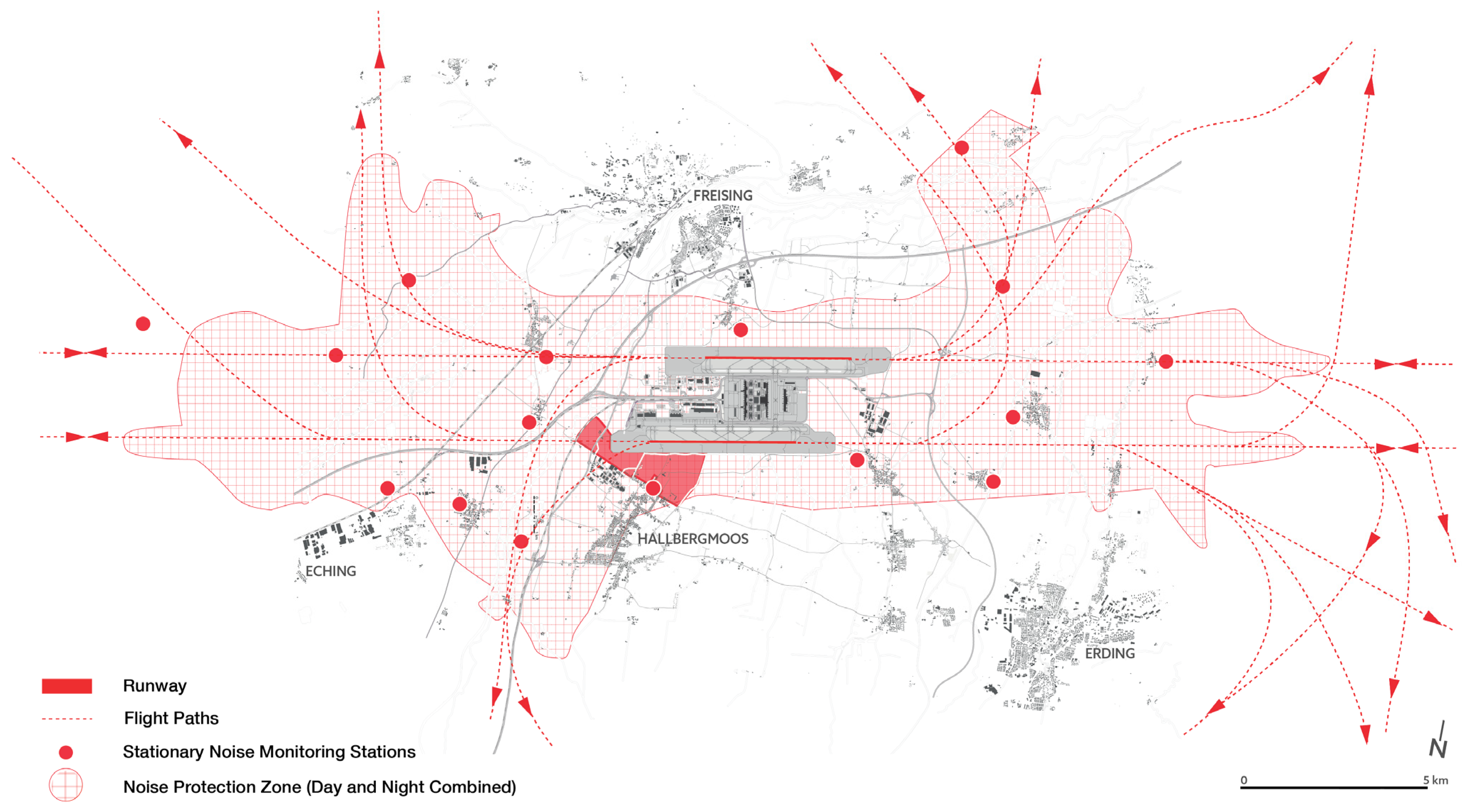
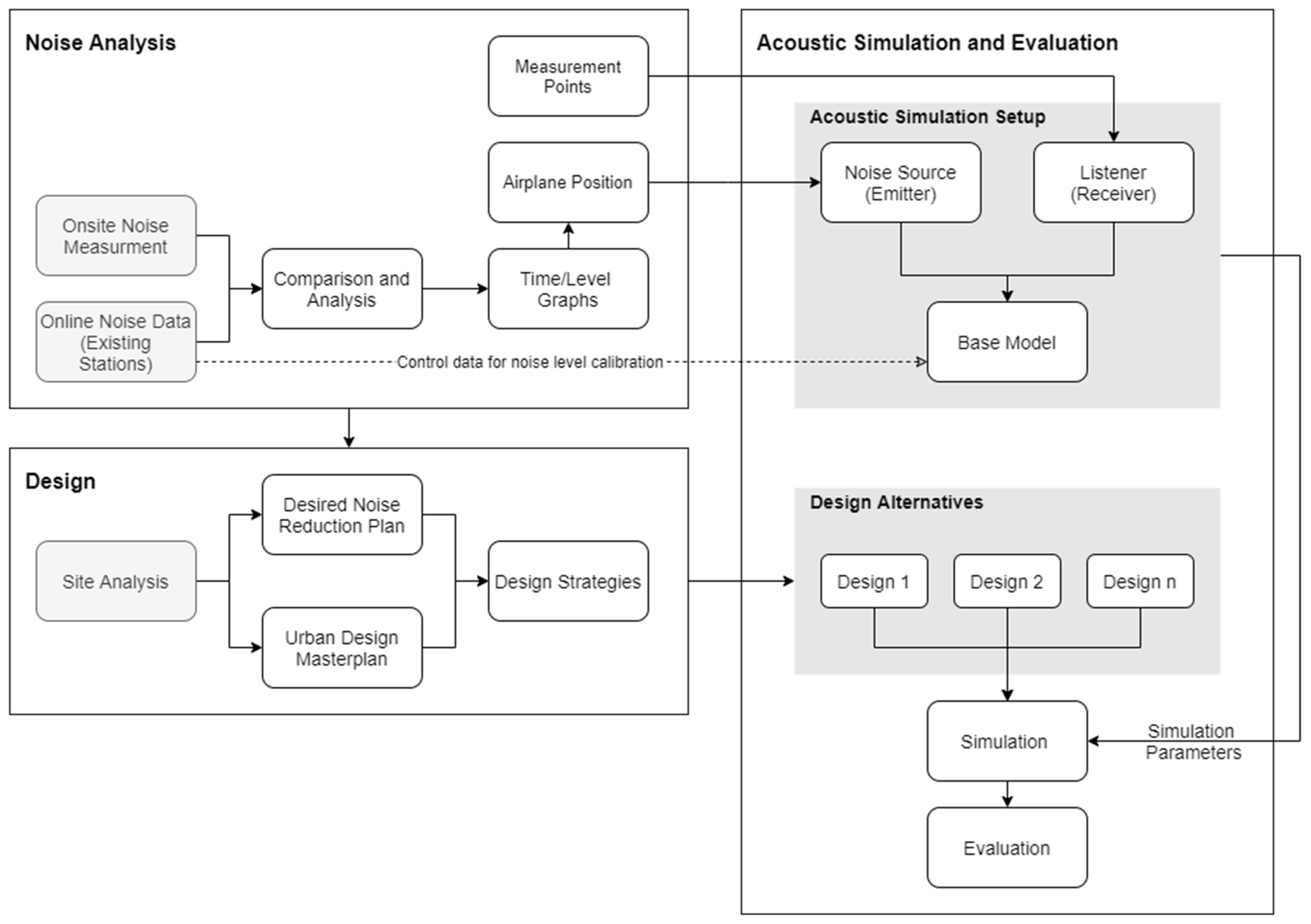
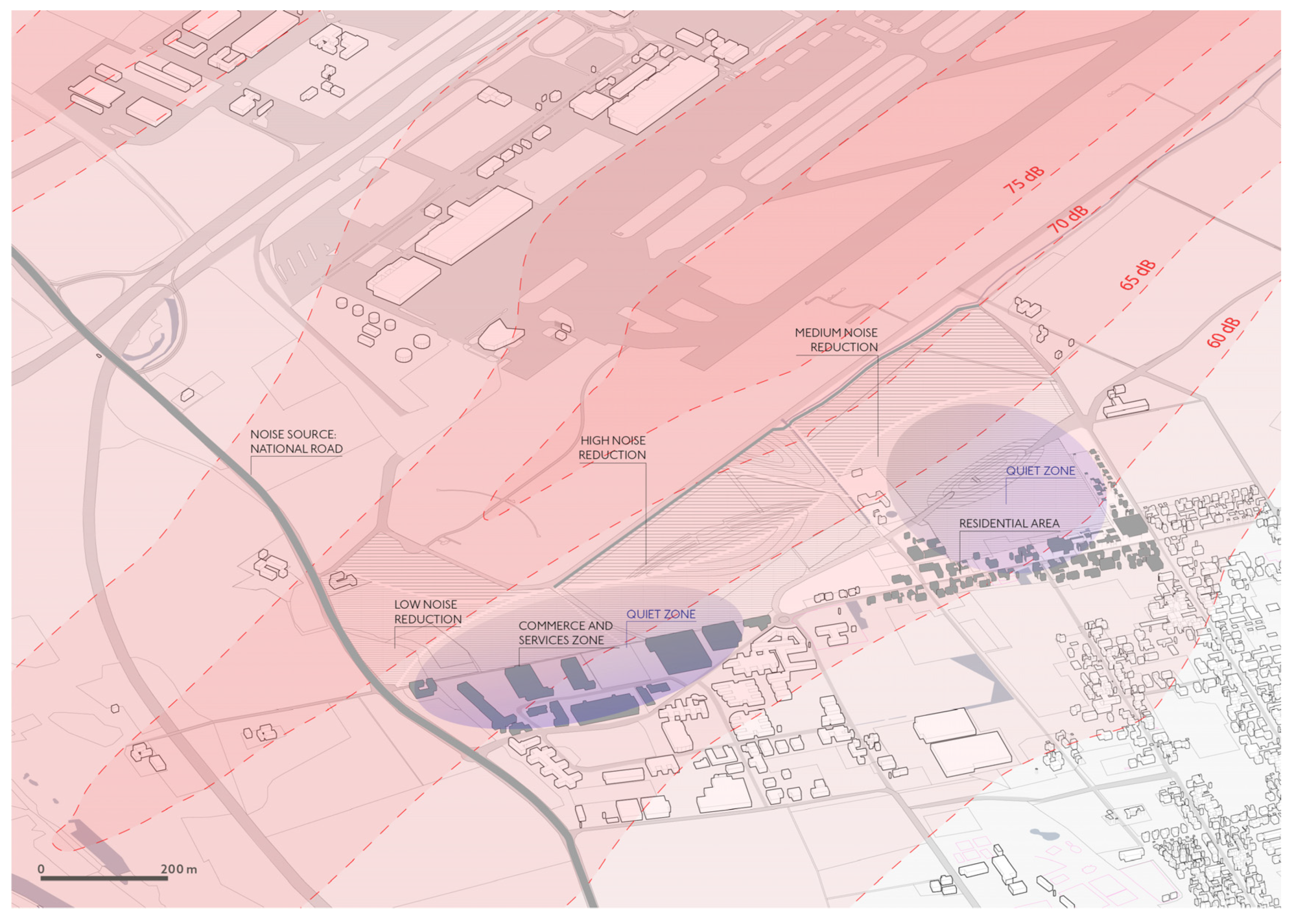
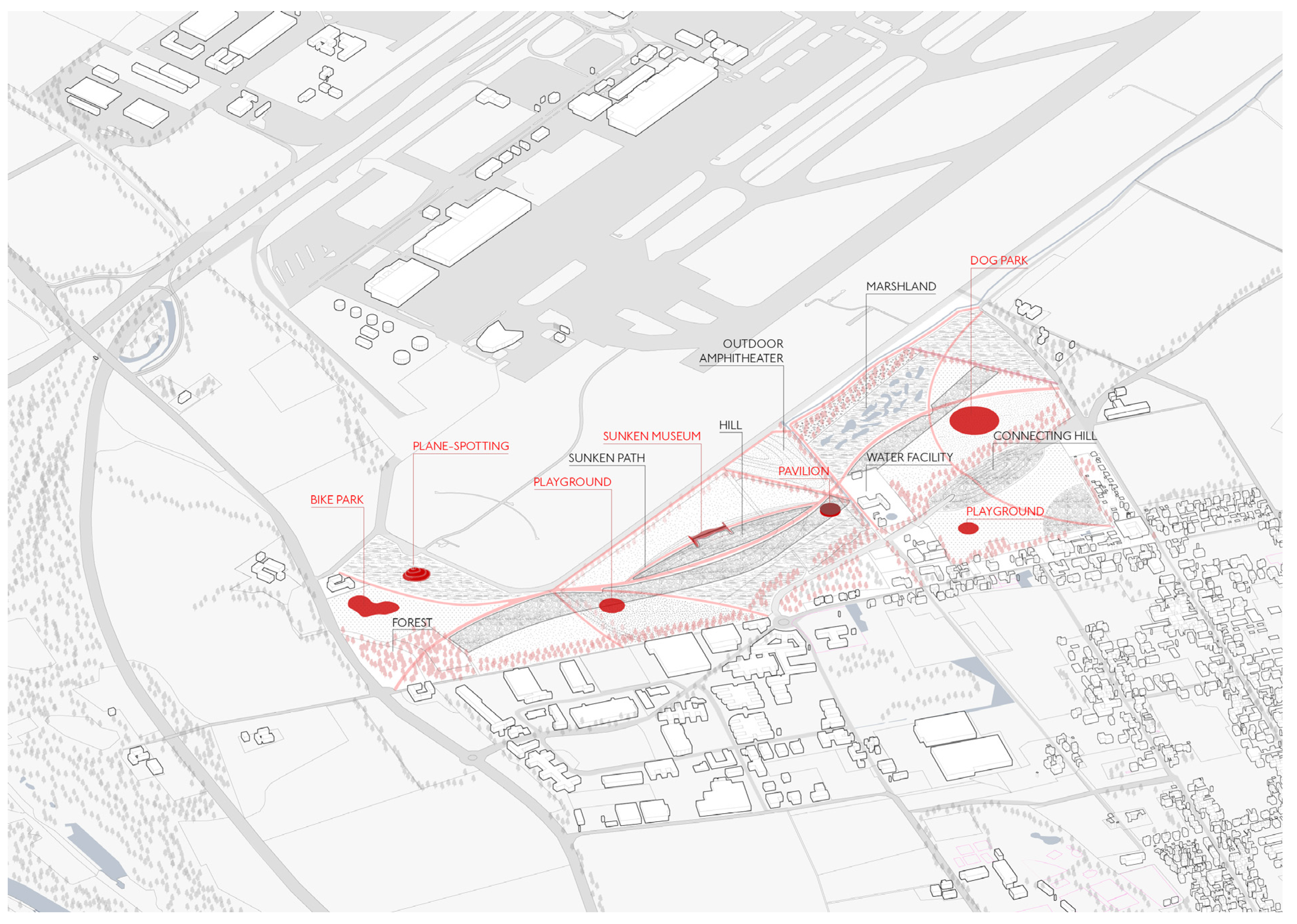
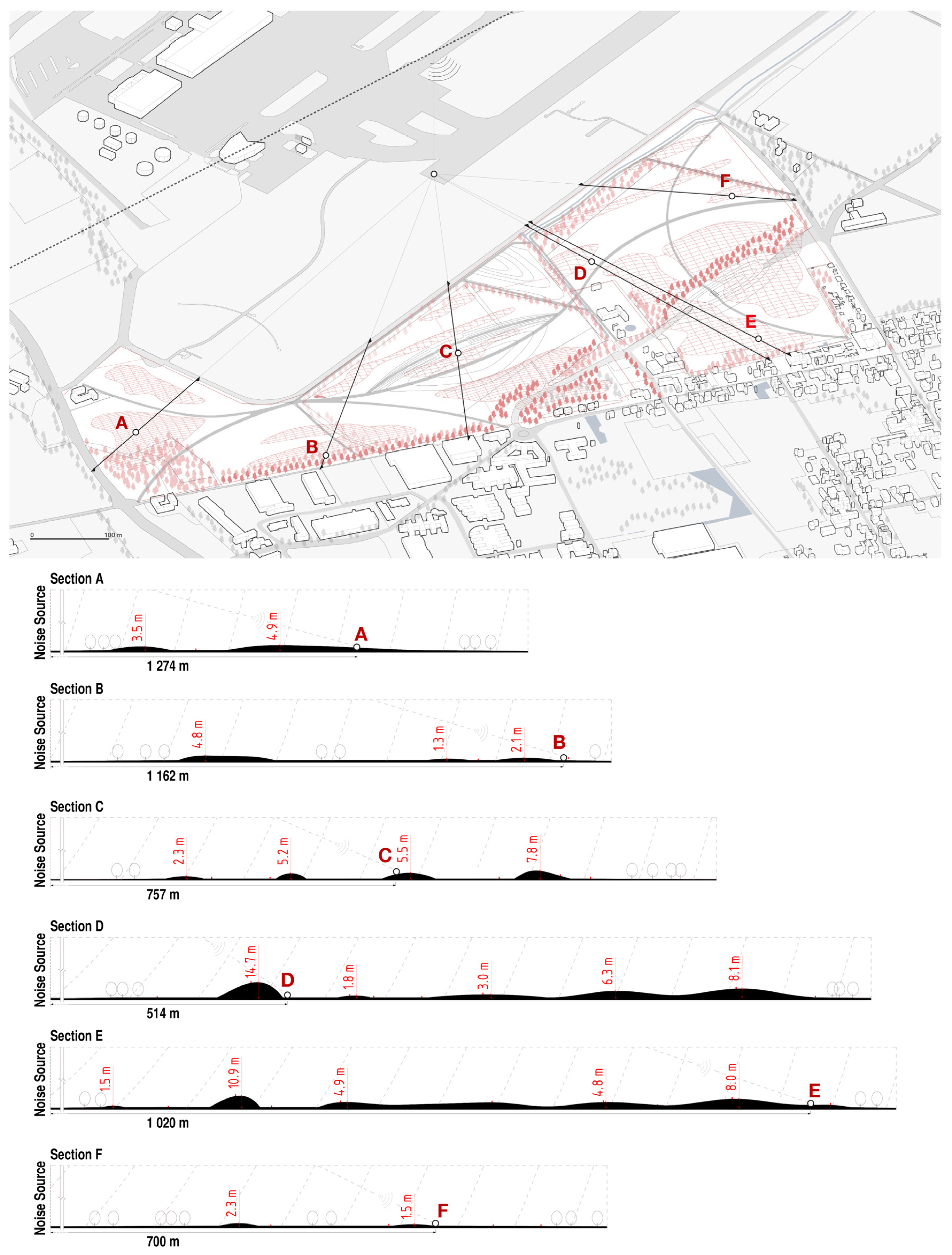
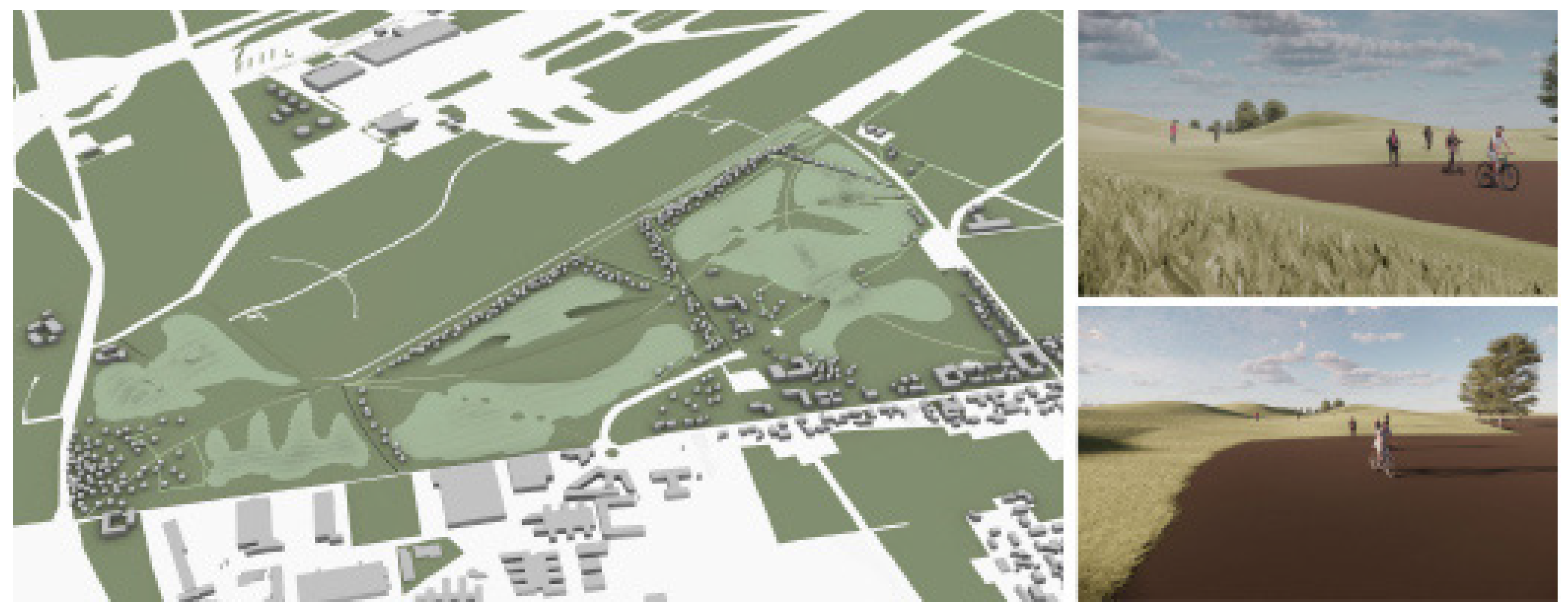


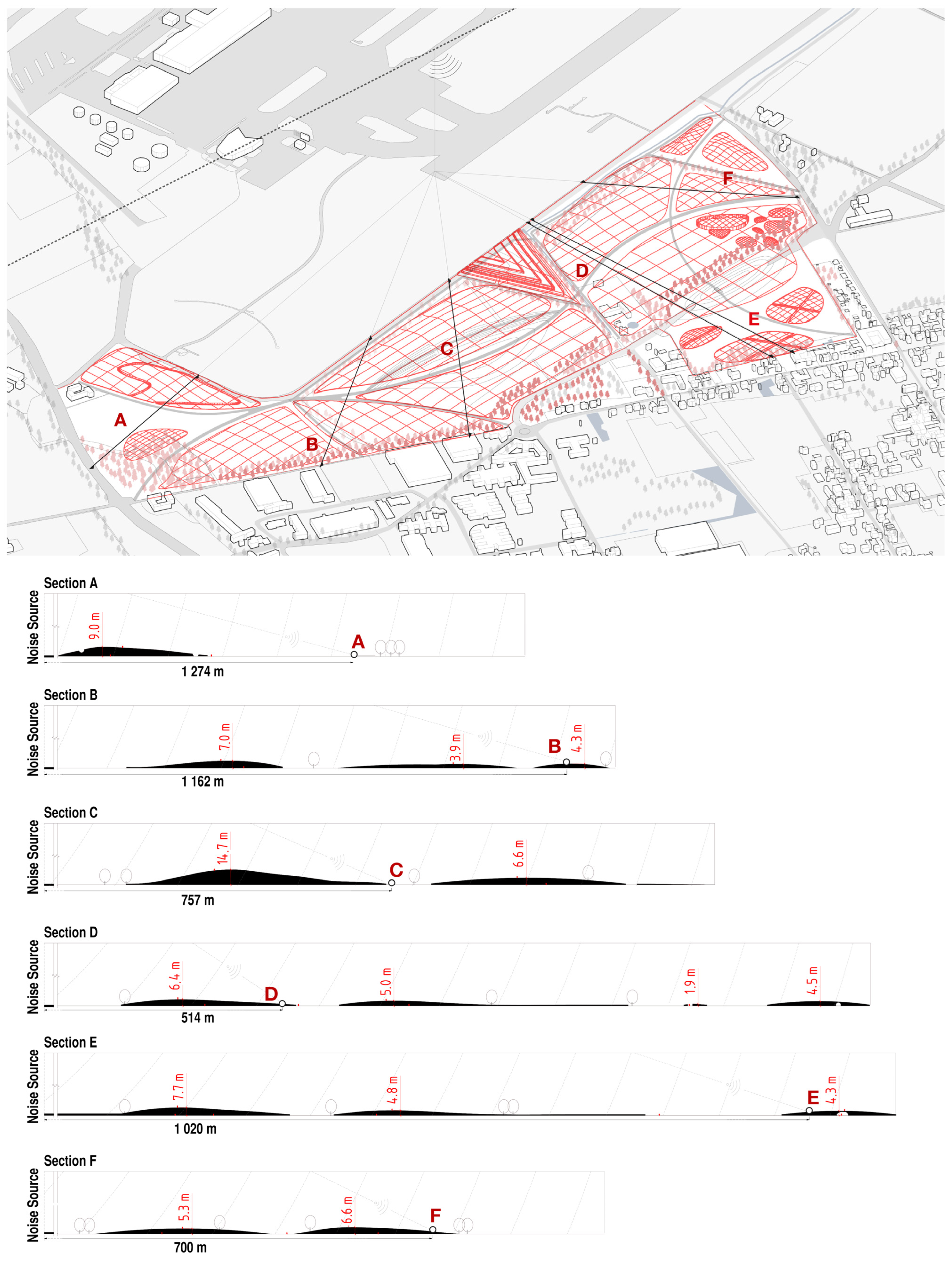
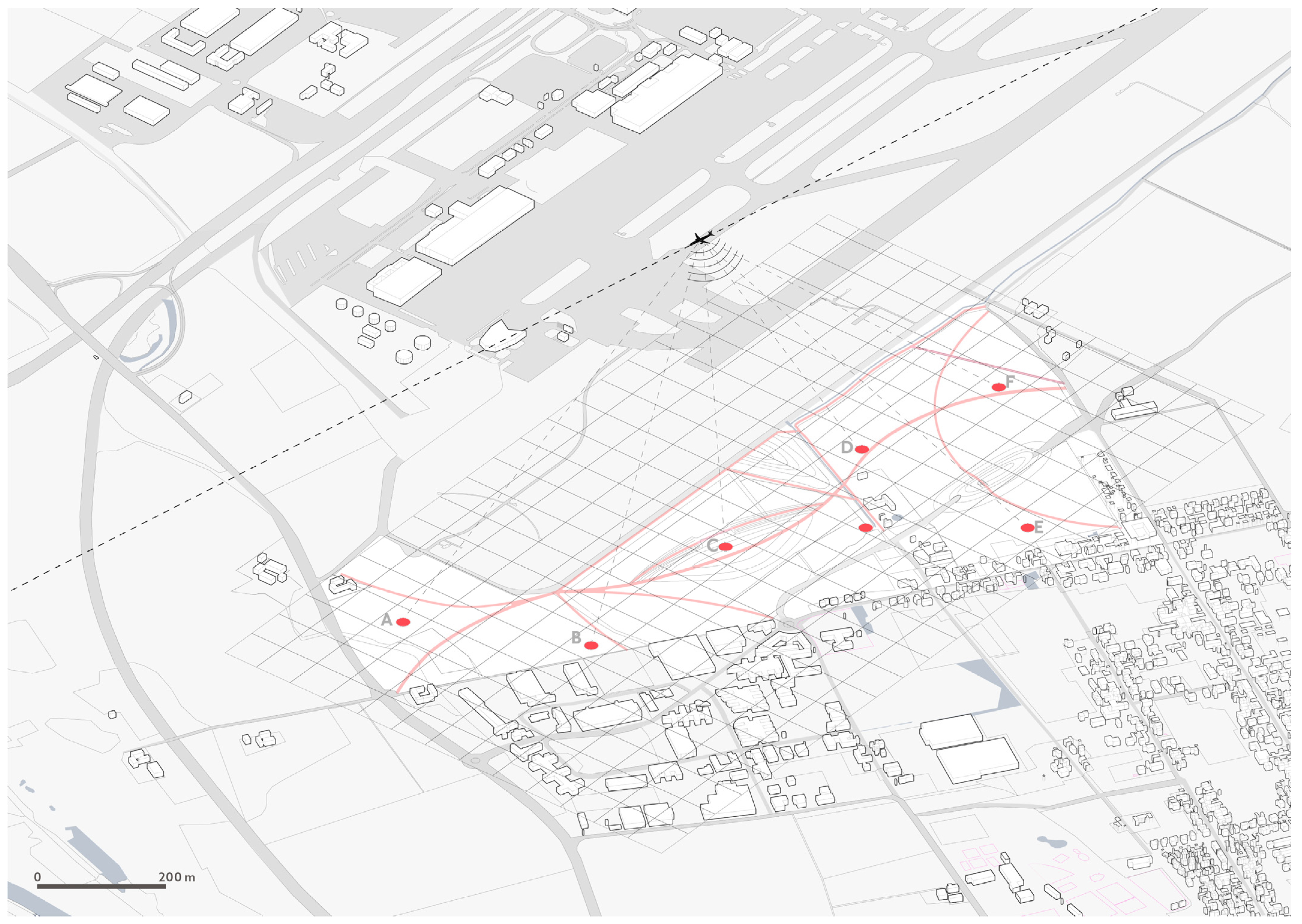
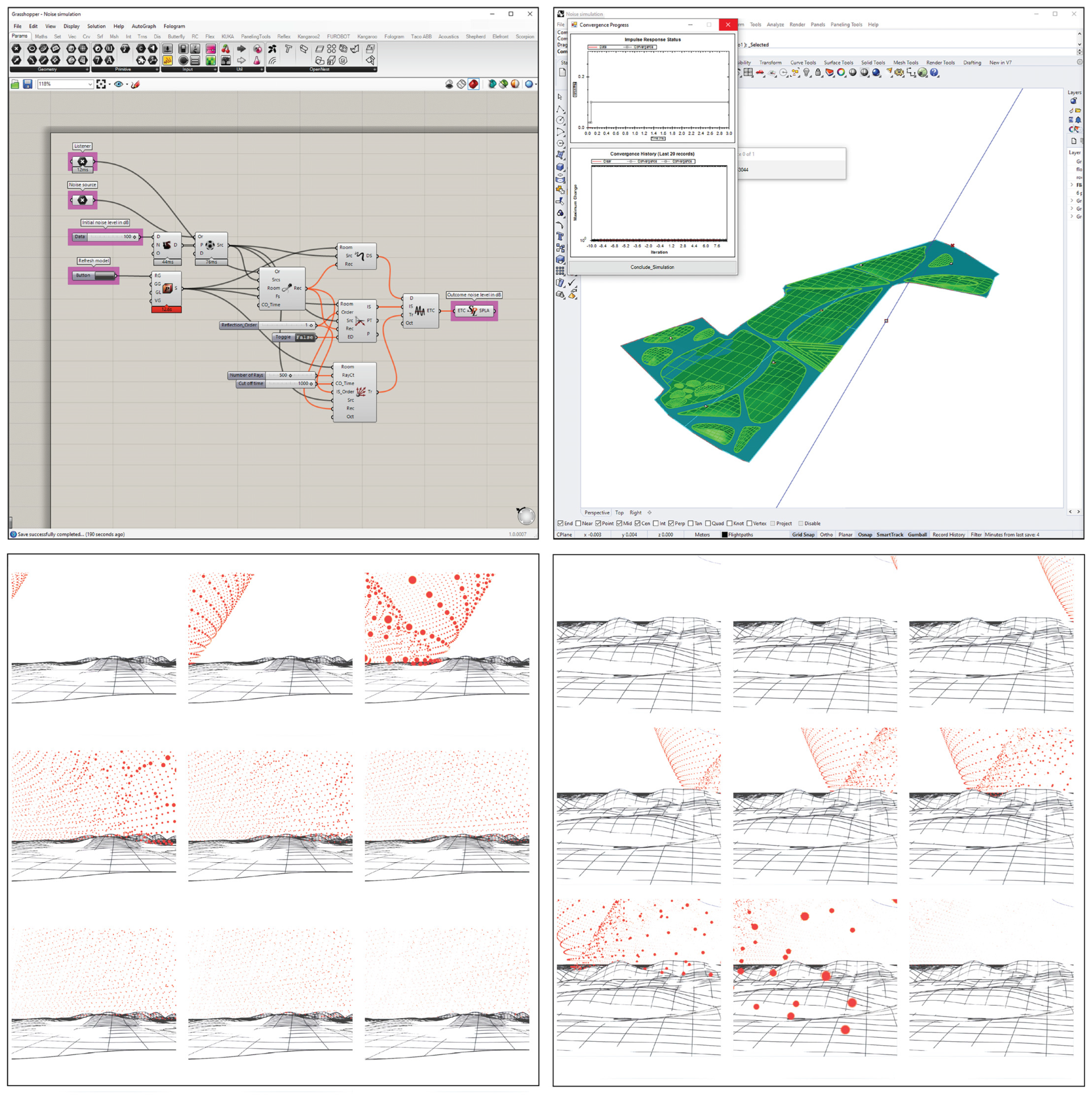
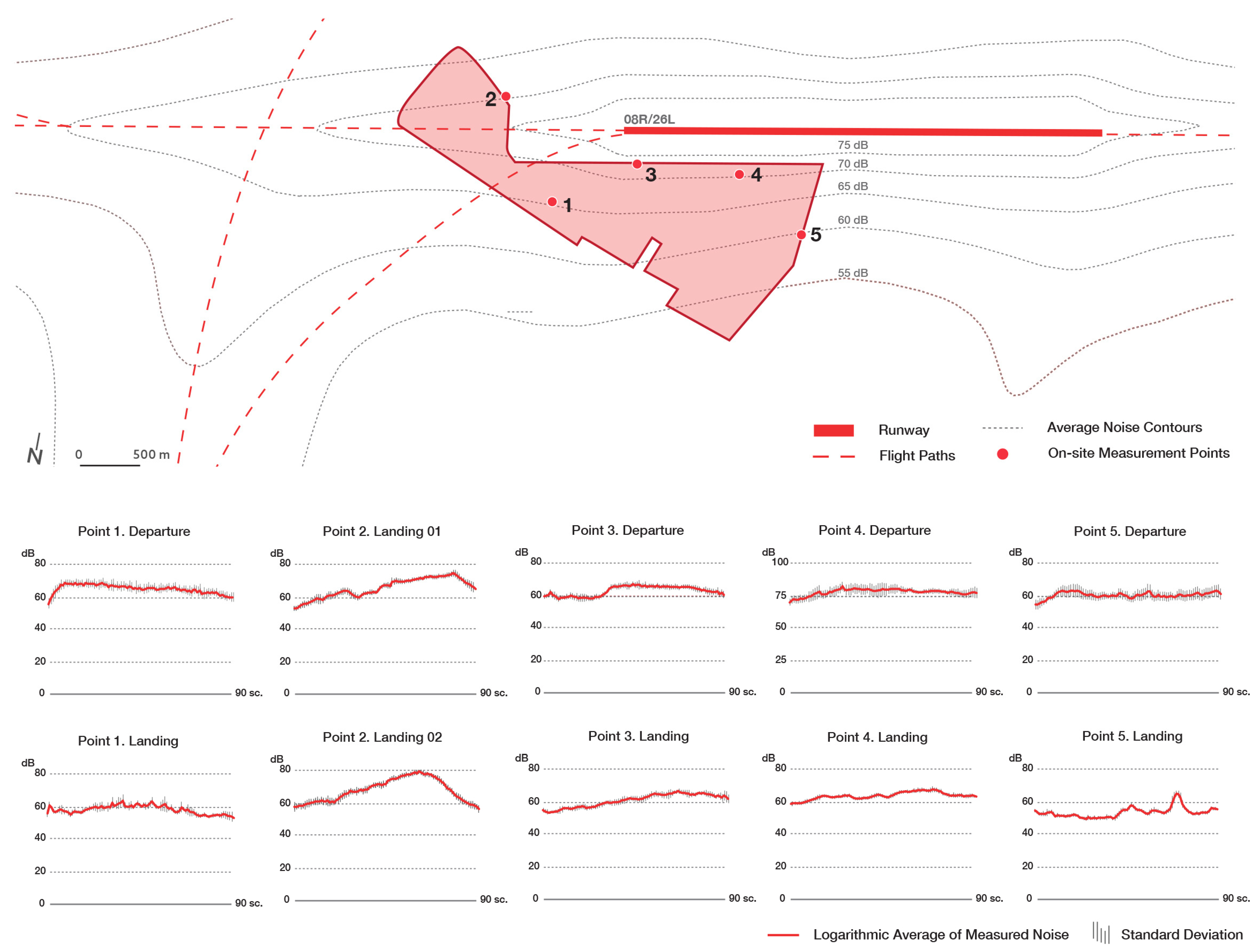
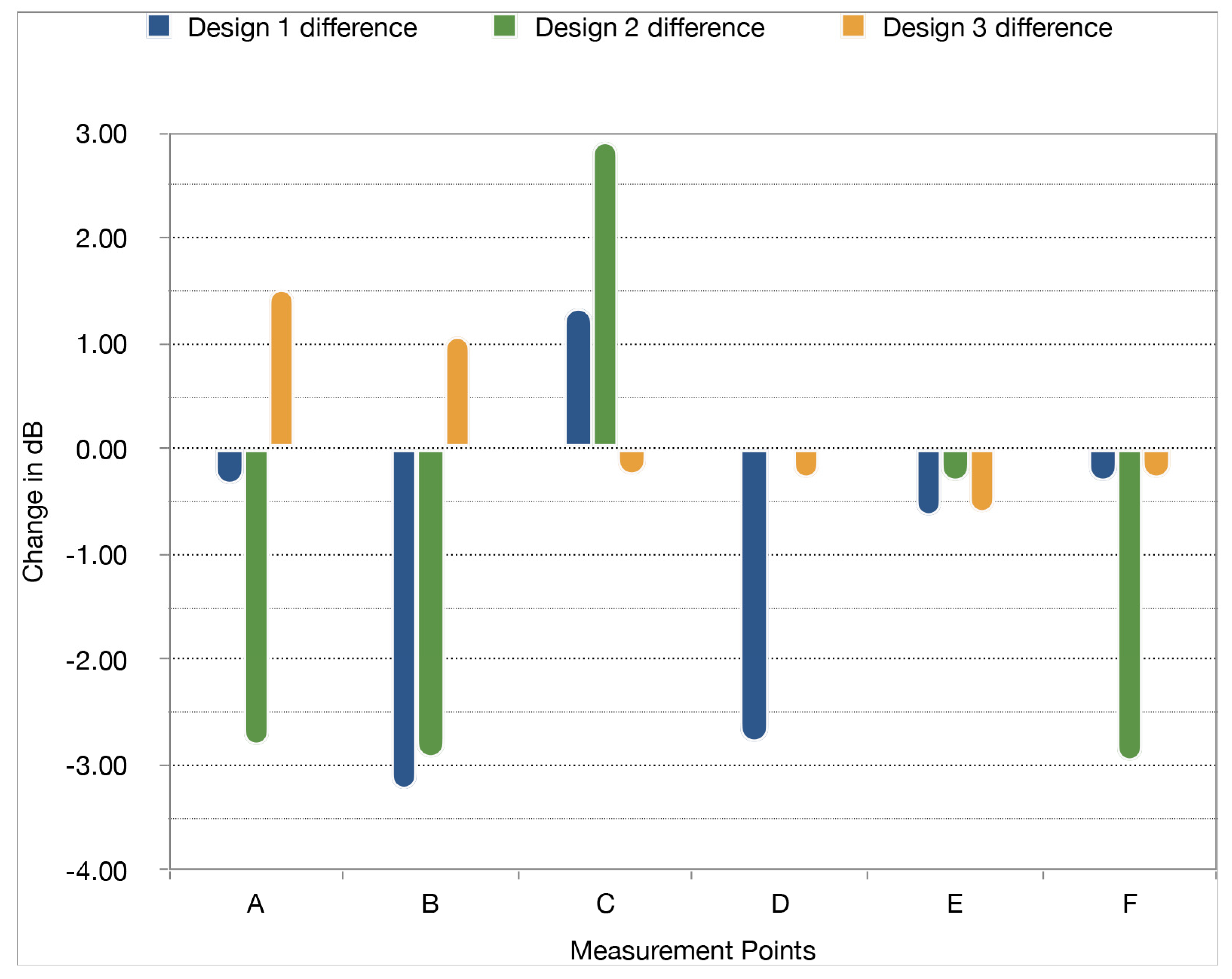
| Device 1 | Device 2 | Device 3 | Device 4 | Device 5 |
|---|---|---|---|---|
| Moto E30 | iPhone X | iPhone 12 Pro Max | iPhone 13 mini | iPad (6th Gen) |
| Evaluation Point | Existing Noise Levels Pre-Operam | Noise Levels Post-Operam | Design 1 Delta–Noise Reduction |
|---|---|---|---|
| A | 68.52 | 68.20 | −0.32 |
| B | 69.38 | 66.14 | −3.24 |
| C | 72.48 | 73.81 | 1.33 |
| D | 74.94 | 72.15 | −2.79 |
| E | 70.55 | 69.91 | −0.64 |
| F | 72.92 | 72.61 | −0.31 |
| Design 1 Average | 71.47 | 70.47 | −1.00 |
| Evaluation Point | Existing Noise Levels Pre-Operam | Noise Levels Post-Operam | Design 2 Delta—Noise Reduction |
|---|---|---|---|
| A | 68.52 | 65.70 | −2.82 |
| B | 69.38 | 66.45 | −2.93 |
| C | 72.48 | 75.40 | 2.92 |
| D | 74.94 | 74.95 | 0.01 |
| E | 70.55 | 70.26 | −0.29 |
| F | 72.92 | 69.96 | −2.96 |
| Design 2 Average | 71.47 | 70.45 | −1.01 |
| Evaluation Point | Existing Noise Levels Pre-Operam | Noise Levels Post-Operam | Design 3 Delta–Noise Reduction |
|---|---|---|---|
| A | 68.52 | 70.04 | 1.52 |
| B | 69.38 | 70.45 | 1.07 |
| C | 72.48 | 72.24 | −0.24 |
| D | 74.94 | 74.67 | −0.27 |
| E | 70.55 | 69.95 | −0.60 |
| F | 72.92 | 72.65 | −0.27 |
| Design 3 Average | 71.47 | 71.67 | 0.20 |
| Evaluation Point | Design 1 Delta | Design 2 Delta | Design 3 Delta |
|---|---|---|---|
| A | −0.32 | −2.82 | 1.52 |
| B | −3.24 | −2.93 | 1.07 |
| C | 1.33 | 2.92 | −0.24 |
| D | −2.79 | 0.01 | −0.27 |
| E | −0.64 | −0.29 | −0.60 |
| F | −0.31 | −2.96 | −0.27 |
| Average | −1.00 | −1.01 | 0.20 |
Disclaimer/Publisher’s Note: The statements, opinions and data contained in all publications are solely those of the individual author(s) and contributor(s) and not of MDPI and/or the editor(s). MDPI and/or the editor(s) disclaim responsibility for any injury to people or property resulting from any ideas, methods, instructions or products referred to in the content. |
© 2023 by the authors. Licensee MDPI, Basel, Switzerland. This article is an open access article distributed under the terms and conditions of the Creative Commons Attribution (CC BY) license (https://creativecommons.org/licenses/by/4.0/).
Share and Cite
Bar-Sinai, K.L.; Shaked, T.; Fettahoglu, E.S.; Krimm, J.; Boucsein, B. Embedding Acoustic Analysis in Landscape Architecture Design Processes: A Case Study of Munich Airport. Buildings 2023, 13, 143. https://doi.org/10.3390/buildings13010143
Bar-Sinai KL, Shaked T, Fettahoglu ES, Krimm J, Boucsein B. Embedding Acoustic Analysis in Landscape Architecture Design Processes: A Case Study of Munich Airport. Buildings. 2023; 13(1):143. https://doi.org/10.3390/buildings13010143
Chicago/Turabian StyleBar-Sinai, Karen Lee, Tom Shaked, Elif Simge Fettahoglu, Jochen Krimm, and Benedikt Boucsein. 2023. "Embedding Acoustic Analysis in Landscape Architecture Design Processes: A Case Study of Munich Airport" Buildings 13, no. 1: 143. https://doi.org/10.3390/buildings13010143
APA StyleBar-Sinai, K. L., Shaked, T., Fettahoglu, E. S., Krimm, J., & Boucsein, B. (2023). Embedding Acoustic Analysis in Landscape Architecture Design Processes: A Case Study of Munich Airport. Buildings, 13(1), 143. https://doi.org/10.3390/buildings13010143






